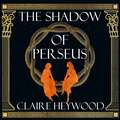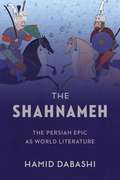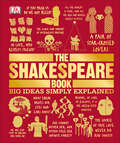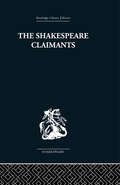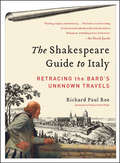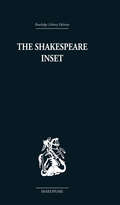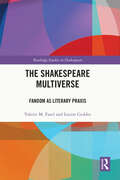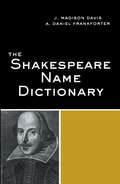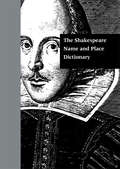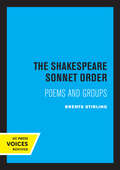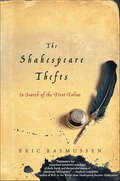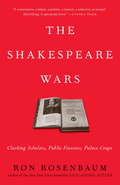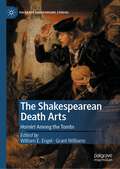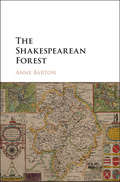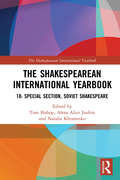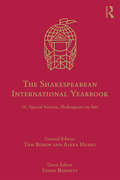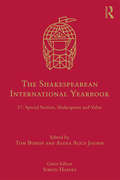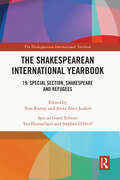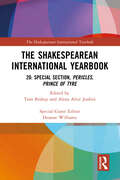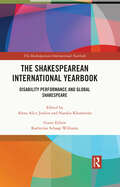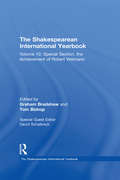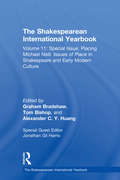- Table View
- List View
The Shadow of Perseus
by Claire HeywoodHistory remembers him as a hero. But the women who knew him best remember a different man...Perseus grows up wanting to be a hero, but he cannot become one if his mother Danae still sees him as a boy. When his stepfather Polydektes casts him away on a voyage across the sea, Perseus is determined to fulfil the great destiny of the son of a god and the grandson of a king. But the line between heroism and monstrosity is thin, and when Perseus attempts to seduce first gentle Medusa and then beautiful Andromeda, before finally reuniting with Danae, they each learn of the dangers of resisting a boy prepared to risk it all for greatness . . .
The Shadow of Perseus: A compelling feminist retelling of the myth of Perseus told from the perspectives of the women who knew him best
by Claire HeywoodThe myth of Perseus, told through the story of the three women who knew him best - his mother Danae, his wife Andromeda, and his victim, Medusa.History remembers him as a hero. But the women who knew him best remember a different man...Perseus grows up wanting to be a hero, but he cannot become one if his mother Danae still sees him as a boy. When his stepfather Polydektes casts him away on a voyage across the sea, Perseus is determined to fulfil the great destiny of the son of a god and the grandson of a king. But the line between heroism and monstrosity is thin, and when Perseus attempts to seduce first gentle Medusa and then beautiful Andromeda, before finally reuniting with Danae, they each learn of the dangers of resisting a boy prepared to risk it all for greatness . . .(p) 2023 Hodder & Stoughton Limited
The Shadows of Poetry: Vergil in the Mind of Augustine (Transformation of the Classical Heritage #26)
by Sabine MacCormackImperial ceremony was a vital form of self-expression for late antique society. Sabine MacCormack examines the ceremonies of imperial arrivals, funerals, and coronations from the late third to the late sixth centuries A.D., as manifest in the official literature and art of the time. Her study offers us new insights into the exercise of power and into the social, political, and cultural significance of religious change during the Christianization of the Roman world.
The Shahnameh: The Persian Epic as World Literature
by Hamid DabashiThe Shahnameh, an epic poem recounting the foundation of Iran across mythical, heroic, and historical ages, is the beating heart of Persian literature and culture. Composed by Abu al-Qasem Ferdowsi over a thirty-year period and completed in the year 1010, the epic has entertained generations of readers and profoundly shaped Persian culture, society, and politics. For a millennium, Iranian and Persian-speaking people around the globe have read, memorized, discussed, performed, adapted, and loved the poem.In this book, Hamid Dabashi brings the Shahnameh to renewed global attention, encapsulating a lifetime of learning and teaching the Persian epic for a new generation of readers. Dabashi insightfully traces the epic’s history, authorship, poetic significance, complicated legacy of political uses and abuses, and enduring significance in colonial and postcolonial contexts. In addition to explaining and celebrating what makes the Shahnameh such a distinctive literary work, he also considers the poem in the context of other epics, such as the Aeneid and the Odyssey, and critical debates about the concept of world literature. Arguing that Ferdowsi’s epic and its reception broached this idea long before nineteenth-century Western literary criticism, Dabashi makes a powerful case that we need to rethink the very notion of “world literature” in light of his reading of the Persian epic.
The Shakespeare Book: Big Ideas Simply Explained (DK Big Ideas)
by DKLearn the entire works of one of the greatest writers of the English language in The Shakespeare Book.Part of the fascinating Big Ideas series, this book tackles tricky topics and themes in a simple and easy to follow format. Learn about the works of William Shakespeare in this overview guide, great for beginners looking to learn and experts wishing to refresh their knowledge alike! The Shakespeare Book brings a fresh and vibrant take on the topic through eye-catching graphics and diagrams to immerse yourself in. This captivating book will broaden your understanding of Shakespeare, with:- Every play and poem from Shakespeare&’s canon, including lost plays and less well-known works of poetry- Packed with facts, charts, timelines and graphs to help explain core concepts- A visual approach to big subjects with striking illustrations and graphics throughout- Easy to follow text makes topics accessible for people at any level of understandingThe Shakespeare Book is the perfect introduction to the entire canon of Shakespeare&’s plays, sonnets, and other poetry, aimed at adults with an interest in the subject and students wanting to gain more of an overview. Here you&’ll discover the complete works, from The Comedy of Errors, to the great tragedies of Hamlet, Othello, King Lear, and Macbeth.Your Shakespeare Questions, Simply ExplainedThis is a brilliant, innovative exploration of the entire canon of Shakespeare plays, sonnets, and other poetry with detailed plot summaries and a full analysis of the major characters and themes. If you thought it was difficult to learn about the works of one of the greatest writers in the English language, The Shakespeare Book presents key information in a simple layout. Every work is covered, from the comedies of Twelfth Night and As You Like It to the tragedies of Julius Caesar and Hamlet, with easy-to-understand graphics and illustrations bringing the themes, plots, characters, and language of Shakespeare to life.The Big Ideas SeriesWith millions of copies sold worldwide, The Shakespeare Book is part of the award-winning Big Ideas series from DK. The series uses striking graphics along with engaging writing, making big topics easy to understand.
The Shakespeare Claimants: A Critical Survey of the Four Principal Theories concerning the Authorship of the Shakespearean Plays
by H. N GibsonThis edition first published in 1962. The Shakespeare Claimants is a critical survey of the great controversy that has raged over the authorship of the Shakespearean plays. It provides the general reader with an outline history of this controversy and with a full description and analysis of the main anti-Stratfordian arguments. This book concentrates on the four main claimants: Bacon, Oxford, Derby and Marlowe. The book contains an extensive bibliography and footnotes to guide the reader through the text.
The Shakespeare Guide to Italy
by Richard Paul RoeRichard Paul Roe spent more than twenty years traveling the length and breadth of Italy on a literary quest of unparalleled significance. Using the text from Shakespeare's ten "Italian Plays" as his only compass, Roe determined the exact locations of nearly every scene in Romeo and Juliet, The Two Gentlemen of Verona, The Merchant of Venice, Much Ado about Nothing, The Tempest, and the remaining dramas set in Italy. His chronicle of travel, analysis, and discovery paints with unprecedented clarity a picture of what the Bard must have experienced before penning his plays. Equal parts literary detective story and vivid travelogue-containing copious annotations and more than 150 maps, photographs, and paintings-The Shakespeare Guide to Italy is a unique, compelling, and deeply provocative journey that will forever change our understanding of how to read the Bard . . . and irrevocably alter our vision of who William Shakespeare really was.
The Shakespeare Inset: Word and Picture
by Francis BerryWhat is the relation between the language being heard and the picture being simultaneously exhibited on the stage? Typically there is an identity between sound and sight, but often there is a divergence between what the audience hears and what is sees. These divergences are 'insets' and examines the motives, mechanics and poetic qualities of these narrative poems embedded in the plays.
The Shakespeare Multiverse: Fandom as Literary Praxis (Routledge Studies in Shakespeare #1)
by Valerie M. Fazel Louise GeddesThe Shakespeare Multiverse: Fandom as Literary Praxis argues that fandom offers new models for a twenty-first century reading practice that embraces affective pleasure and subjective self-positioning as a means of understanding a text. Part critical study, part source book, The Shakespeare Multiverse suggests that fannish contributions to the ongoing expansion of the object that we call Shakespeare is best imagined as a multiverse, encompassing different worlds that consolidate the various perspectives that different fans bring to Shakespeare. Our concept of the multiverse redefines ‘Shakespeare’ not as a singular body of work, but as space where a process of inquiry and cultural memory – memories in the making, and those already made – is influenced and shaped by the technologies available to the reader. Characteristic of fandom is an intertextual reading strategy that we term cyborg reading, an approach that accommodates the varied elements of identity, politics, culture, sexuality, and race that shape the ways that Shakespeare is explored and appropriated throughout fannish reading communities. The Shakespeare Multiverse intersects literary theory, fan studies, and popular culture as it traverses Shakespeare fandom from the 1623 Folio to the age of the Internet, exploring the different textures of fan affect, from those who firmly uphold fidelity to the text to those who sit on the very edge of the fandom, threatening to cross over into Shakespearean anti-fandom. By recognizing the literary value of fandom, The Shakespeare Multiverse offers a new approach to literary criticism that challenges the limits of hegemonic authority and recognizes the value of a joyfully speculative critical praxis.
The Shakespeare Name Dictionary
by J. Madison Davis Daniel A. FrankforterEntries provide the likely sources for a name; describe historical and mythological backgrounds; examine Shakespeare's presentation of a character or place; and suggest various interpretations of a name. Each entry contains line citations to William Shakespeare: The Complete Works. A guide to the historical, mythological, fictional, and geographic references that appear in Shakespeare's complete plays and poems, covering every name, proper adjective, official title, literary and mystical title, and place name.
The Shakespeare Name and Place Dictionary
by A. Daniel Frankforter J. Madison DavisEntries provide the likely sources for a name; describe historical and mythological backgrounds; examine Shakespeare's presentation of a character or place; and suggest various interpretations of a name. Each entry contains line citations to William Shakespeare: The Complete Works, edited by Wells and Taylor, Oxford University Press, 1986.
The Shakespeare Sonnet Order: Poems and Groups
by Brents StirlingThis title is part of UC Press's Voices Revived program, which commemorates University of California Press’s mission to seek out and cultivate the brightest minds and give them voice, reach, and impact. Drawing on a backlist dating to 1893, Voices Revived makes high-quality, peer-reviewed scholarship accessible once again using print-on-demand technology. This title was originally published in 1968.
The Shakespeare Thefts: In Search of the First Folios
by Eric RasmussenPart literary detective story, part Shakespearean lore, The Shakespeare Thefts will charm the Bard's many fans.The first edition of Shakespeare's collected works, the First Folio, published in 1623, is one of the most valuable books in the world and has historically proven to be an attractive target for thieves. Of the 160 First Folios listed in a census of 1902, 14 were subsequently stolen-and only two of these were ever recovered. In his efforts to catalog all these precious First Folios, renowned Shakespeare scholar Eric Rasmussen embarked on a riveting journey around the globe, involving run-ins with heavily tattooed criminal street gangs in Tokyo, bizarre visits with eccentric, reclusive billionaires, and intense battles of wills with secretive librarians. He explores the intrigue surrounding the Earl of Pembroke, arguably Shakespeare's boyfriend, to whom the First Folio is dedicated and whose personal copy is still missing. He investigates the uncanny sequence of events in which a wealthy East Coast couple drowned in a boating accident and the next week their First Folio appeared for sale in Kansas. We hear about Folios that were censored, the pages ripped out of them, about a volume that was marked in red paint-or is it blood?-on every page; and of yet another that has a bullet lodged in its pages.
The Shakespeare Wars: Clashing Scholars, Public Fiascoes, and Palace Coups
by Ron Rosenbaum"[Ron Rosenbaum] is one of the most original journalists and writers of our time."-David Remnick. In The Shakespeare Wars, Ron Rosenbaum gives readers an unforgettable way of rethinking the greatest works of the human imagination. As he did in his groundbreaking Explaining Hitler, he shakes up much that we thought we understood about a vital subject and renews our sense of excitement and urgency. He gives us a Shakespeare book like no other. Rather than raking over worn-out fragments of biography, Rosenbaum focuses on cutting-edge controversies about the true source of Shakespeare's enchantment and illumination-the astonishing language itself. How best to unlock the secrets of its spell? With quicksilver wit and provocative insight, Rosenbaum takes readers into the midst of fierce battles among the most brilliant Shakespearean scholars and directors over just how to delve deeper into the Shakespearean experience-deeper into the mind of Shakespeare.Was Shakespeare the one-draft wonder of Shakespeare in Love? Or was he rather-as an embattled faction of textual scholars now argues-a different kind of writer entirely: a conscientious reviser of his greatest plays? Must we then revise our way of reading, staging, and interpreting such works as Hamlet and King Lear? Rosenbaum pursues key partisans in these debates from the high tables of Oxford to a Krispy Kreme doughnut shop in a strip mall in the Deep South. He makes ostensibly arcane textual scholarship intensely seductive-and sometimes even explicitly sexual. At an academic "Pleasure Seminar" in Bermuda, for instance, he examines one scholar's quest to find an orgasm in Romeo and Juliet. Rosenbaum shows us great directors as Shakespearean scholars in their own right: We hear Peter Brook-perhaps the most influential Shakespearean director of the past century-disclose his quest for a "secret play" hidden within the Bard's comedies and dramas. We listen to Sir Peter Hall, founder of the Royal Shakespeare Company, as he launches into an impassioned, table-pounding fury while discussing how the means of unleashing the full intensity of Shakespeare's language has been lost-and how to restore it. Rosenbaum's hilarious inside account of "the Great Shakespeare 'Funeral Elegy' Fiasco," a man-versus-computer clash, illustrates the iconic struggle to define what is and isn't "Shakespearean." And he demonstrates the way Shakespearean scholars such as Harold Bloom can become great Shakespearean characters in their own right. The Shakespeare Wars offers a thrilling opportunity to engage with Shakespeare's work at its deepest levels. Like Explaining Hitler, this book is destined to revolutionize the way we think about one of the overwhelming obsessions of our time.
The Shakespearean Archive
by Alan GaleyWhy is Shakespeare so often associated with information technologies and with the idea of archiving itself? Alan Galey explores this question through the entwined histories of Shakespearean texts and archival technologies over the past four centuries. In chapters dealing with the archive, the book, photography, sound, information, and data, Galey analyzes how Shakespeare became prototypical material for publishing experiments, and new media projects, as well as for theories of archiving and computing. Analyzing examples of the Shakespearean archive from the seventeenth century to today, he takes an original approach to Shakespeare and new media that will be of interest to scholars of the digital humanities, Shakespeare studies, archives, and media history. Rejecting the idea that current forms of computing are the result of technical forces beyond the scope of humanist inquiry, this book instead offers a critical prehistory of digitization read through the afterlives of Shakespeare's texts.
The Shakespearean Death Arts: Hamlet Among the Tombs (Palgrave Shakespeare Studies)
by Grant Williams William E. EngelThis is the first book to view Shakespeare’s plays from the prospect of the premodern death arts, not only the ars moriendi tradition but also the plurality of cultural expressions of memento mori, funeral rituals, commemorative activities, and rhetorical techniques and strategies fundamental to the performance of the work of dying, death, and the dead. The volume is divided into two sections: first, critically nuanced examinations of Shakespeare’s corpus and then, second, of Hamlet exclusively as the ultimate proving ground of the death arts in practice. This book revitalizes discussion around key and enduring themes of mortality by reframing Shakespeare’s plays within a newly conceptualized historical category that posits a cultural divide—at once epistemological and phenomenological—between premodernity and the Enlightenment.
The Shakespearean Forest
by Anne BartonThe Shakespearean Forest, Anne Barton's final book, uncovers the pervasive presence of woodland in early modern drama, revealing its persistent imaginative power. The collection is representative of the startling breadth of Barton's scholarship: ranging across plays by Shakespeare (including Titus Andronicus, As You Like It, Macbeth, The Two Gentlemen of Verona and Timon of Athens) and his contemporaries (including Jonson, Dekker, Lyly, Massinger and Greene), it also considers court pageants, treatises on forestry and chronicle history. Barton's incisive literary analysis characteristically pays careful attention to the practicalities of performance, and is supplemented by numerous illustrations and a bibliographical essay exploring recent scholarship in the field. Prepared for publication by Hester Lees-Jeffries, featuring a Foreword by Adrian Poole and an Afterword by Peter Holland, the book explores the forest as a source of cultural and psychological fascination, embracing and illuminating its mysteriousness.
The Shakespearean International Yearbook 18: Special Section: Soviet Shakespeare (The Shakespearean International Yearbook)
by Tom BishopFor its eighteenth volume, The Shakespearean International Yearbook surveys the present state of Shakespeare studies, addressing issues that are fundamental to our interpretive encounter with Shakespeare’s work and his time, across the whole spectrum of his literary output. Contributions are solicited from among the most active and insightful scholars in the field, from both hemispheres of the globe. New trends are evaluated from the point of view of established scholarship, and emerging work in the field is encouraged. Each issue includes a special section under the guidance of a specialist guest editor, along with coverage of the current state of the field. An essential reference tool for scholars of early modern literature and culture, this annual publication captures, from year to year, current and developing thought in Shakespeare scholarship and theater practice worldwide. There is a particular emphasis on Shakespeare studies in global contexts.
The Shakespearean International Yearbook: 16: Special Section, Shakespeare on Site (The Shakespearean International Yearbook)
by Alexa Huang Tom BishopShakespearean performances regularly take place at both historic sites and locations with complex resonances, such as Shakespeare’s Globe Theatre in London and the royal castle of Hamlet – Elsinore – in Denmark. The present issue of the Shakespeare International Yearbook examines the impact of specificities such as festivals and performance sites on our understanding of Shakespeare and globalization. Contributions survey the present state of Shakespeare studies and address issues that are fundamental to our interpretive encounter with Shakespeare's work and his time, across the whole spectrum of his literary output.
The Shakespearean International Yearbook: 17: Special Section, Shakespeare and Value (The Shakespearean International Yearbook)
by Alexa Alice Joubin Tom BishopCurrently in its seventeenth year and formerly published by Ashgate, The Shakespearean International Yearbook surveys the present state of Shakespeare studies, addressing issues that are fundamental to our interpretive encounter with Shakespeare's work and his time, across the whole spectrum of his literary output. Contributions are solicited from among the most active and insightful scholars in the field, from both hemispheres of the globe. New trends are evaluated from the point of view of established scholarship, and emerging work in the field encouraged, to present a view of what is happening all around the world. Each issue includes a special section under the guidance of a specialist Guest Editor, as well as a review of recent critical work in Shakespeare studies. An essential reference tool for scholars of early modern literature and culture, this annual captures, from year to year, current and developing thought in Shakespeare scholarship and theater practice worldwide.
The Shakespearean International Yearbook: 19: Special Section, Shakespeare and Refugees (The Shakespearean International Yearbook)
by Ton Hoenselaars Alexa Alice Joubin Tom Bishop Stephen O’NeillPublishing its nineteenth volume, The Shakespearean International Yearbook surveys the present state of Shakespeare studies, addressing issues that are fundamental to our interpretive encounter with Shakespeare’s work and his time, across the whole spectrum of his literary output. Contributions are solicited from scholars across the field, from both hemispheres of the globe. New trends are evaluated from the point of view of established scholarship, and emerging work in the field is encouraged. Each issue includes a special section under the guidance of a specialist Guest Editor, along with coverage of the current state of the field in other aspects. An essential reference tool for scholars of early modern literature and culture, this annual publication captures, from year to year, current and developing thought in Shakespeare scholarship and theater practice worldwide. There is a particular emphasis on Shakespeare studies in global contexts.
The Shakespearean International Yearbook: 20: Special Section, Pericles, Prince of Tyre (The Shakespearean International Yearbook)
by Deanne Williams Alexa Alice Joubin Tom BishopThis year publishing its twentieth volume, The Shakespearean International Yearbook surveys the present state of Shakespeare studies, addressing issues that are fundamental to our interpretive encounter with Shakespeare’s work and his time, across the whole spectrum of his literary output. Contributions are solicited from scholars across the field, from both hemispheres of the globe. New trends are evaluated from the point of view of established scholarship, and emerging work in the field is encouraged. Each issue includes a special section under the guidance of a specialist Guest Editor, along with coverage of the current state of the field in other aspects. An essential reference tool for scholars of early modern literature and culture, this annual publication captures, from year to year, current and developing thought in Shakespeare scholarship and theater practice worldwide. There is a particular emphasis on Shakespeare studies in global contexts.
The Shakespearean International Yearbook: Disability Performance and Global Shakespeare (The Shakespearean International Yearbook)
by Alexa Alice Joubin Katherine Schaap Williams Natalia KhomenkoThe Shakespearean International Yearbook surveys the present state of Shakespeare studies in global contexts, addressing issues that are fundamental to our interpretive encounter with Shakespeare’s work and his time. Contributions are solicited from scholars across the field and from both hemispheres of the globe who represent diverse career stages and linguistic traditions. Both new and ongoing trends are examined in comparative contexts, and emerging voices in different cultural contexts are featured alongside established scholarship. Each volume features a collection of articles that focus on a theme curated by a specialist Guest Editor, along with coverage of the current state of the field in other aspects. An essential reference tool for scholars of early modern literature and culture, this annual publication captures, from year to year, current and developing thought in global Shakespeare scholarship and performance practice worldwide.
The Shakespearean International Yearbook: Volume 10: Special Section, the Achievement of Robert Weimann (The Shakespearean International Yearbook)
by Graham Bradshaw and Tom BishopThis eighth volume of The Shakespearean International Yearbook presents a special section on 'European Shakespeares', proceeding from the claim that Shakespeare's literary craft was not just native English or British, but was filtered and fashioned through a Renaissance awareness that needs to be recognized as European, and that has had effects and afterlives across the Continent. Guest editors Ton Hoenselaars and Clara Calvo have constructed this section to highlight both how the spread of 'Shakespeare' throughout Europe has brought together the energies of a wide variety of European cultures across several centuries, and how the inclusion of Shakespeare in European culture has been not only a European but also a world affair. The Shakespearean International Yearbook continues to provide an annual survey of important issues and developments in contemporary Shakespeare studies. Contributors to this issue come from the US and the UK, Spain, Switzerland and South Africa, Canada, The Netherlands, India, Portugal, Greece, France, and Hungary. In addition to the section on European Shakespeares, this volume includes essays on the genre of romance, issues of character, and other topics.
The Shakespearean International Yearbook: Volume 11: Special Issue, Placing Michael Neill. Issues of Place in Shakespeare and Early Modern Culture (The Shakespearean International Yearbook)
by Alexander C. Y. Huang Jonathan Gil Harris Tom Bishop Graham BradshawThis eighth volume of The Shakespearean International Yearbook presents a special section on 'European Shakespeares', proceeding from the claim that Shakespeare's literary craft was not just native English or British, but was filtered and fashioned through a Renaissance awareness that needs to be recognized as European, and that has had effects and afterlives across the Continent. Guest editors Ton Hoenselaars and Clara Calvo have constructed this section to highlight both how the spread of 'Shakespeare' throughout Europe has brought together the energies of a wide variety of European cultures across several centuries, and how the inclusion of Shakespeare in European culture has been not only a European but also a world affair. The Shakespearean International Yearbook continues to provide an annual survey of important issues and developments in contemporary Shakespeare studies. Contributors to this issue come from the US and the UK, Spain, Switzerland and South Africa, Canada, The Netherlands, India, Portugal, Greece, France, and Hungary. In addition to the section on European Shakespeares, this volume includes essays on the genre of romance, issues of character, and other topics.

